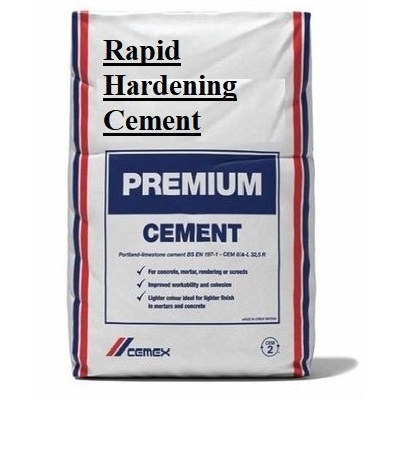Rapid hardening cement is a special type of cement that achieves high strength in a shorter time. In general, the strength achieved by ordinary cement in 7 days is equal to the strength achieved in 3 days.
This type of cement is also called High-Early Strength Portland Cement. This article describes the manufacturing process, properties, uses, and benefits of rapid hardening cement.

This type of cement is resistant to sulfates. It is used in areas such as road surfaces to allow traffic to open faster. It is also used in the production of prefabricated slabs, columns, poles, and concrete in cold countries.
Table of Contents
Composition
Rapid hardening cement contains various ingredients as given below.
- 60% Tricalcium silicate (C3S),
- 15% Dicalcium silicate (C2S),
- 10% Tricalcium aluminate (C3A) and
- 8% Tetracalcium aluminoferrite of the total weight of cement.
Manufacturing Process of Rapid Hardening Cement
This type of cement is fired at higher temperatures than OPC under more controlled conditions.
This cement is made from limestone and shale and heated to extremely high temperatures to form a clinker. The lime and shale clinker are then mixed with a small amount of gypsum and ground very fine to form a fast-setting cement. All the difference between rapid hardening cement and regular Portland cement is the amount of limestone (tricalcium silicate) used as a raw material that gives the cement a high initial strength.
Characteristics
- Initial setting time: 30 minutes
- Final setting time: 600 minutes
- The specific surface area of 3250 cm2/g or more.
- RHC is lighter than OPC.
- The curing time of rapid hardening cement is shorter.
- This cement should be stored in a dry place. Otherwise, the quality will deteriorate due to premature carbonation and hydration.
Uses
- It is used when the formwork needs to be removed as soon as possible for reuse.
- Used where high initial strength is required.
- It is mainly used as a pavement where it is important to open the road quickly.
- It is used in industries that produce concrete products such as slabs, electric poles, electric poles, and block fences because the mold can be quickly removed.
- It is used in cold weather concrete because the rapid release of heat during hydration protects the concrete from freezing.
Benefit of RHC
- A short curing period is required.
- Resistant to sulfate attacks. Shrinkage is reduced during the hardening and hardening of the cement.
- Fast setting cement is used in areas such as road surfaces to allow traffic to open faster.
- It is also used in the production of prefabricated slabs, columns, poles, and concrete in cold countries.
- It has high strength on the first day and allows the formwork to be removed faster than other types of cement.
- It’s a very durable cement that fits the fast pace of construction and the budget you need to get the project done.
